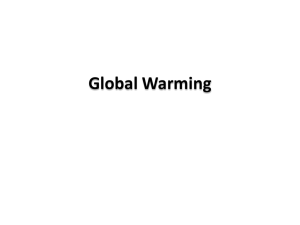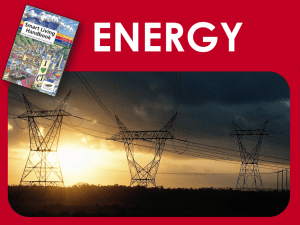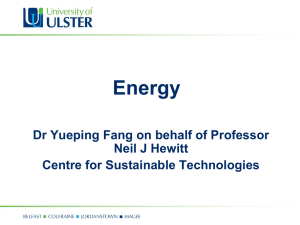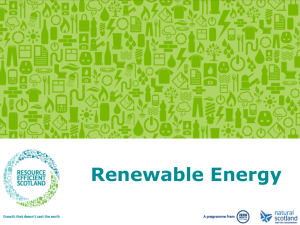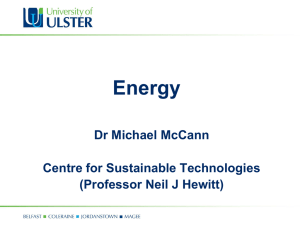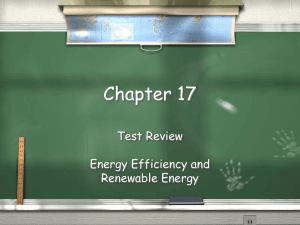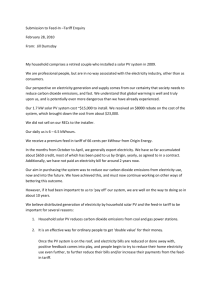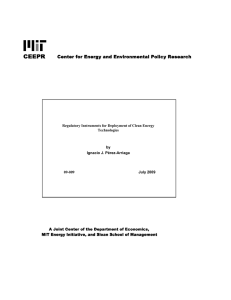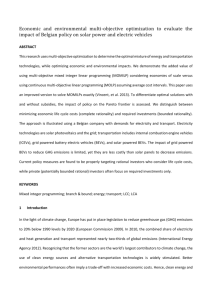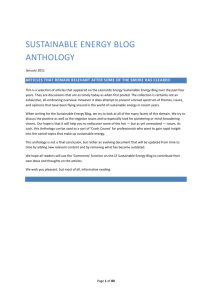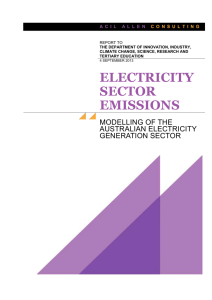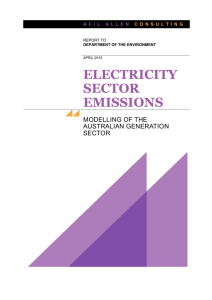Fact vs. Fiction - Center for Climate and Energy Decision Making
advertisement
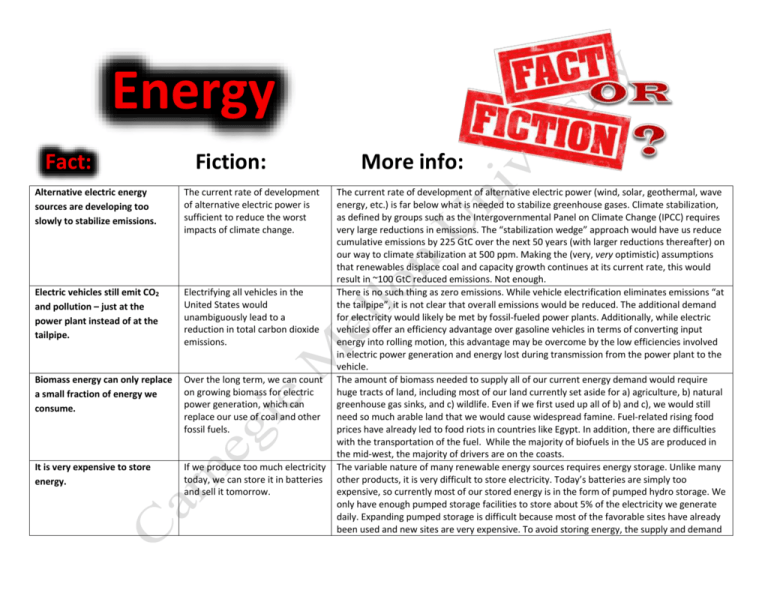
Energy Fact: Fiction: Alternative electric energy sources are developing too slowly to stabilize emissions. The current rate of development of alternative electric power is sufficient to reduce the worst impacts of climate change. Electric vehicles still emit CO2 and pollution – just at the power plant instead of at the tailpipe. Electrifying all vehicles in the United States would unambiguously lead to a reduction in total carbon dioxide emissions. Biomass energy can only replace a small fraction of energy we consume. Over the long term, we can count on growing biomass for electric power generation, which can replace our use of coal and other fossil fuels. It is very expensive to store energy. If we produce too much electricity today, we can store it in batteries and sell it tomorrow. More info: The current rate of development of alternative electric power (wind, solar, geothermal, wave energy, etc.) is far below what is needed to stabilize greenhouse gases. Climate stabilization, as defined by groups such as the Intergovernmental Panel on Climate Change (IPCC) requires very large reductions in emissions. The “stabilization wedge” approach would have us reduce cumulative emissions by 225 GtC over the next 50 years (with larger reductions thereafter) on our way to climate stabilization at 500 ppm. Making the (very, very optimistic) assumptions that renewables displace coal and capacity growth continues at its current rate, this would result in ~100 GtC reduced emissions. Not enough. There is no such thing as zero emissions. While vehicle electrification eliminates emissions “at the tailpipe”, it is not clear that overall emissions would be reduced. The additional demand for electricity would likely be met by fossil-fueled power plants. Additionally, while electric vehicles offer an efficiency advantage over gasoline vehicles in terms of converting input energy into rolling motion, this advantage may be overcome by the low efficiencies involved in electric power generation and energy lost during transmission from the power plant to the vehicle. The amount of biomass needed to supply all of our current energy demand would require huge tracts of land, including most of our land currently set aside for a) agriculture, b) natural greenhouse gas sinks, and c) wildlife. Even if we first used up all of b) and c), we would still need so much arable land that we would cause widespread famine. Fuel-related rising food prices have already led to food riots in countries like Egypt. In addition, there are difficulties with the transportation of the fuel. While the majority of biofuels in the US are produced in the mid-west, the majority of drivers are on the coasts. The variable nature of many renewable energy sources requires energy storage. Unlike many other products, it is very difficult to store electricity. Today’s batteries are simply too expensive, so currently most of our stored energy is in the form of pumped hydro storage. We only have enough pumped storage facilities to store about 5% of the electricity we generate daily. Expanding pumped storage is difficult because most of the favorable sites have already been used and new sites are very expensive. To avoid storing energy, the supply and demand Solar and wind energy can only replace a small fraction of the energy we consume. The wind blows mostly at night and the sun shines only during the day, so between these two renewable sources of electricity, we won’t need any other fuels! Energy efficiency is using less energy for an application, energy conservation uses no energy. Energy efficiency and energy conservation are the same thing. Nuclear plants do not release greenhouse gases during their operation. Nuclear plants release carbon dioxide into the air during their operation. Including capital and maintenance costs, power from solar panels is much more expensive than both conventional and wind power. Because it is so sunny in the South-Western United States, we could build enough solar panels there to power the entire country. This would be inexpensive because energy from the sun is free. Appliances that use a lot of energy also use a lot of power. Energy is to power as distance is to speed. Smart meters simply provide information to electricity companies. Smart meters have immediate benefits to consumers. for electricity must be balanced instantaneously (likely through rather elaborate engineering and market designs). Some day in the distant future, we may be able to meet our need for electricity with the variable generation of renewables. However, the energy system is very large and changes take a long time. Our lifetimes will be a time when we are transitioning between dirtier, older sources such as coal and natural gas plants towards cleaner sources. In the last decade, Germany has invested heavily in renewable energy (€26 billion in 2010 alone!). Despite these large investments, renewable energies only rose from 6.5% in 2000 to 25% in 2012. Germany has the ambitious goal of increasing that to 35% by 2020; the remaining 65% will still have to come from fossil fuels or nuclear power. Energy efficiency is employing a process or technology that requires less energy to perform the same task (e.g., using CFLs instead of incandescent light bulbs). Energy conservation is a behavioral change leading to different activities that require less energy (e.g., turning off the lights when not in the room). Conventional power plants operate by triggering chemical reactions in which fuels are burned to produce energy, carbon dioxide, and some by-products. In nuclear power, no chemical reactions occur, and thus no greenhouse gases are released to the atmosphere. Of course, there are many problems with nuclear power, including large and unpredictable costs, waste management, the risk of meltdowns and associated dispersal of radioactive material, the unpredictable nature of multi-modal failures, public perception, and the potential for proliferation. Note: Nuclear power plants will not detonate as popularly shown in movies. While there are no fuel costs associated with solar power, there are substantial capital costs – solar panels cost much more per kW than conventional generators or wind. There may also be substantial maintenance costs for large arrays of solar panels operated in desert areas due to the need to remove sand from the surface of panels. Additionally, building substantial numbers of generators in the South-Western U.S. would require tremendous investment in transmission lines to carry the electricity to urban and industrial centers. Transmission lines cost on the order of $1 million per mile in favorable terrain. Energy is the capacity of a system to perform work, and power defines how fast you are using or producing energy. Energy and power usage differ; i.e., microwave uses a lot of power but is only rarely running and so it uses little energy. A refrigerator uses less power but is on all the time, so it uses more energy. Smart meters are often confused with in-home displays and smart thermostats. They cannot control consumer’s electricity use - they won’t shut off an appliance, nor save consumers money on their electricity bill. The purpose of smart meters is to improve the reliability of the grid by providing more information to electricity companies about fluctuating electricity demand. However, this technology does enable some of the aforementioned devices to be used. Questions: 1. Can alternative energy sources be used to stabilize emissions? 2. Are electric cars zero-emission? 3. Can biomass serve as a substitute for fossil fuel? 4. Could solar and wind be our only energy sources? 5. What is energy efficiency? What is energy conservation? Does energy efficiency of energy conservation work better? 6. Do nuclear power plants release greenhouse gases during their operation? 7. What is the largest obstacle for dealing with the variability of renewable energy sources? Can we easily store energy? 8. Sun is for free and we have tons of it in the South. Compared to other renewable energy sources, is solar energy cheap 9. Are solar panels an efficient energy source? 10. What is the difference between energy and power? 11. What are smart meters? What is their purpose?

